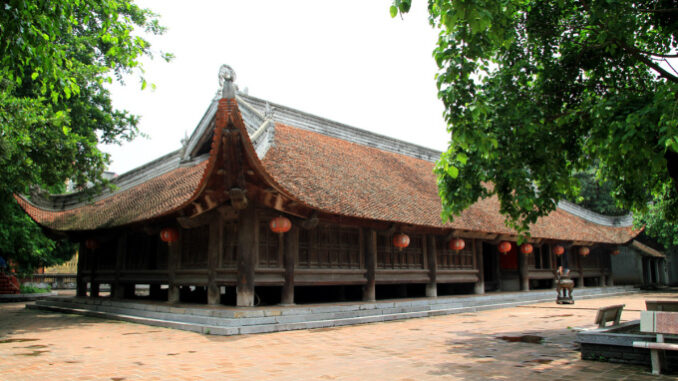
Do Temple in Tu Son city is likened to a land of sacred gas gathering, a place to worship the emperors of the Ly dynasty.
On the afternoon of September 22, the National Assembly Standing Committee agreed to establish Tu Son city, Bac Ninh on the basis of the status quo of more than 61 square kilometers and 202,800 people of Tu Son town. The new city of Bac Ninh province has advantages in traffic, geographical location, history, and culture, attracting tourists from the North. There are many works, valuable attractions for visitors.
Do Temple

The temple, also known as Ly Bat De temple or Co Phap Dien in Dinh Bang ward, Tu Son city, is the place to worship 8 kings of the Ly dynasty and commemorate the flourishing dynasty that lasted for more than 200 years. The work has a massive scale, elaborately built with the image of Thang Long capital. Legend has it that the temple was built by King Ly Thai Tong in 1030 and was continuously restored and expanded with the style of “foreign domestic and foreign affairs”, surrounded by a wall consisting of dozens of works divided into two zones.
In 1952, France bombed and destroyed the entire temple architecture. In 1989, the Do Temple was rebuilt as before, completely inheriting the Ly Dynasty style and folklore according to the drawings of the researchers. Every year in the third lunar month here holds the Do Temple festival which takes place in 3 days 14, 15, and 16 to commemorate the day King Ly Thai To ascended the throne. At the end of 2014, the temple was ranked as a special national historical and cultural relic.
Kim Dai Temple

About 3 km from Do Temple is Kim Dai Pagoda, also known as Dai Pagoda, Quynh Lam Pagoda, and Luc To Pagoda, which is one of the temples with the oldest history in Vietnam. According to history books, the pagoda was built in the 8th century, in the Ly dynasty, this is one of the largest and most beautiful pagodas, it is said to be the place where Ly Cong Uan (King Ly Thai To), the founder of the Ly Dynasty, once He was a monk at the temple when he was young.
Dinh Dinh Bang

The communal house is made entirely of ironwood, has the most beautiful architecture on stilts in the North, also known as Bang communal house, located on high ground in Dinh Bang ward, Tu Son city, built by mandarin Nguyen Thac Luong. from 1700 to 1736.
Like many Vietnamese communal houses in the late 17th and early 18th centuries, Dinh Bang communal house has a superficial architecture in harmony with nature. The communal house has a long, high roof, curved blades, roofed with thick, wide, and thick tiles. The communal house worships the gods Cao Son Dai Vuong, Bach Le Dai Vuong, Thuy Ba Dai Vuong, and Luc To who restored Dinh Bang village in the 15th century, after being destroyed by the Ming invaders.
Tieu Pagoda

The temple in Tuong Giang ward, Tu Son city is an ancient temple of Bac Ninh province, located in the middle of a pure mountain, all year round with quiet trees. The temple, consisting of the Three Jewels, the ancestral house, the stele house, and ancillary buildings, was a major Buddhist center in the Ly dynasty.
Currently, this place preserves many ancient documents and anecdotes reflecting the life and background of King Ly Thai To from his childhood. Coming to Tieu Pagoda, visitors can also admire the mysterious and precious statue of Zen Master Nhu Tri in Vietnam. Besides, this is a rare temple that does not have a merit box in the North, the tables now only have fruits, sweets, incense lamps…
